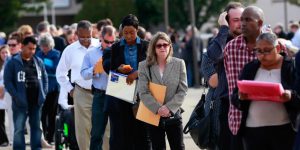APRIL 2, 2020

- US weekly jobless claims have spiked to a second consecutive weekly record as coronavirus-induced layoffs persist across the country.
- The Labor Department reported Thursday that 6.64 million Americans filed for unemployment insurance in the week that ended Saturday — more than double the previous week’s total.
- Economists expect the US to fall into recession in the second quarter if it isn’t already in one. The sky-high jobless claims could raise the unemployment rate by multiple percentage points.
- “What is striking about this crisis is how broad, how deep, and how rapid these cuts have been,” Julia Pollak, a labor economist at ZipRecruiter, told Business Insider.
A record number of Americans have filed for unemployment benefits for a second straight week as a nationwide coronavirus lockdown continues to force layoffs.
US weekly jobless claims jumped to 6.64 million in the week that ended Saturday, the Labor Department reported Thursday. That is more than double the prior week’s report, which itself reflected filings that more than quadrupled the previous record.

“It’s remarkable,” the Bank of America economist Joseph Song told Business Insider. “These are unprecedented numbers, but we’re also facing an unprecedented pandemic,” he said, adding that the report was consistent with the strict containment measures seen around the US to try to curb the spread of the disease COVID-19.
Unemployment claims had spiked to a then-record 3.28 million for the week that ended March 21. Now, almost 10 million Americans have filed for unemployment in just two weeks.
The surge started in mid-March, when the US ramped up social-distancing measures to combat the coronavirus pandemic, shutting down schools and factories and sending many workers home.
Since the previous report, more states have followed with increased guidelines encouraging people to stay inside, and President Donald Trump extended federal social-distancing guidelines through April 30. In addition, major corporations such as General Electric and Macy’s have announced layoffs or furloughed workers.
“What is striking about this crisis is how broad, how deep, and how rapid these cuts have been,” Julia Pollak, a labor economist at ZipRecruiter, told Business Insider.
This week’s report also revised last week’s number higher by 24,000, saying weekly jobless claims were actually 3.3 million in the week that ended March 21. It said the number could have been undercounted because of issues at state unemployment offices, which were inundated with calls and unable to process them quickly enough.
An overwhelmed system
Aaron Heaps, 28, an actor, filed for unemployment in New York in March when the show he was working on — the national tour of “Finding Neverland” — was canceled as social gatherings were banned to curb the spread of COVID-19. At the same time, jobs he usually worked at restaurants in the city were on hold as nonessential businesses closed because of the outbreak.
Heaps told Business Insider he spent four days in a row calling the New York unemployment office.
“The website was crashing, so there was no point in even trying that,” he said. Eventually, he got through and was able to receive benefits. He’s hopeful his restaurant jobs in the city will be safe after the pandemic but is worried about acting jobs — the outbreak hit during what is usually a busy audition season.
“I’m hoping to go back to lots of auditions,” he said. “But I may go back to there being nothing.”
The economic impact
Most economists expect the US to fall into recession in the second quarter of 2020, if it isn’t in one already. Goldman Sachs is forecasting that US gross domestic product output will shrink by 34% in the second quarter and the unemployment rate will spike to 15% in the second half of the year.
While the late-March unemployment numbers won’t show up in the monthly jobs report to be released Friday, they will have a large impact on the April report, released in May. Millions of Americans out of work could raise the unemployment rate, previously at historic lows, by multiple percentage points.
The White House is working with Congress to provide relief for the US economy, aiming to effectively pause it until it can be reopened following the coronavirus pandemic. On Friday, Trump signed a $2 trillion coronavirus relief package into law.
The law is expected to send checks to most American households, give much-needed help to distressed businesses, and expand unemployment by adding as much as $600 a week to state benefits.
Will mass unemployment continue?
Expanded benefits are needed to keep the economy afloat until work can resume and consumers can go out and spend again. The additional benefits could also boost unemployment claims in the future, as more workers than ever now qualify for help, Elise Gould, an economist at the Economic Policy Institute, told Business Insider.
Still, unemployment-insurance-claims numbers are most likely an underestimate of true economic pain, she said, as there will always be some people who aren’t able to access applications or don’t know they’re eligible for benefits. There will also be companies that simply do not make it through the economic downturn, she said.
The next question is when the claims reports will slow down, the Glassdoor economist Daniel Zhao told Business Insider.
“The economy and the labor market will bounce back once the crisis is over. The question is really when, exactly, and how quickly,” he said. “Once people start getting back to work, will everybody be able to find a job again?”
But forecasting in this unprecedented situation is difficult.
“The numbers are so large and they may be bigger than what they’re showing,” Gould said. “You have nothing in history that looks like this. So how do we even make predictions for what is going on here?”
Courtesy/Source: Business Insider










































































































